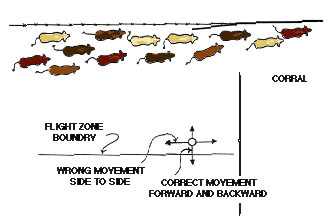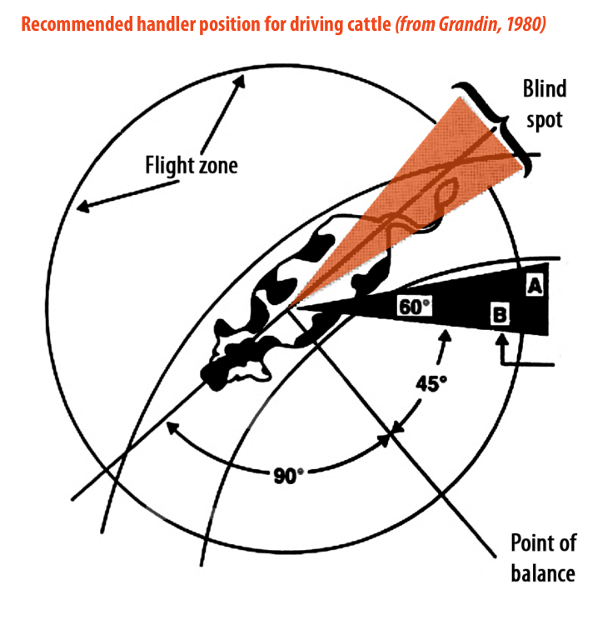It is very important that you understand that animals such as beef cattle that are normally kept on extensive grazing (open grazing) veldt are not as tame as dairy cows. You must therefore be careful when you approach such animals in the field especially when they have young calves.
Herdsmen need to respect the animal’s territory and be careful when approaching them. Your presence can be the reason why the animal becomes defensive. Like humans, animals have a personal space within which they will become uncomfortable when approached. Experienced herdsmen know how to keep a critical distance/flight zone during herding and handling.
The Flight Zone
This is the area or space surrounding the animal or group of animals. When a person enters this zone, the animal will move away until it feels safe. If the person retreats, the animal usually stops moving away.
Figure: This diagram illustrates the general flight zone of an animal. The actual flight zone of an individual animal will vary depending on how "tame" the animal is. An animal's flight zone will vary depending on how calm it is. The flight zone gets bigger when an animal becomes excited. The flight zone is also bigger when you approach "head-on". Calm cattle are easier to move. If cattle become excited, it takes 20 to 30 minutes for them to calm back down.
Different animals have different flight zones. Tame animals have a much smaller flight zone than wild animals.


Using the principles of flight zone behaviour, a handler is able to move cattle into a pen in a calm and orderly way. Using the positions shown on this diagram will enable the handler to control the flow of cattle through the gate. Cattle movement can be slowed or speeded up by moving forward or backwards.
Point of Balance

To keep animals, calm and move them easily, the handler should work on the edge of the flight zone. He penetrates the flight zone to make the animals move and he backs up if he wants them to stop moving. The best positions are shown on the diagram. The handler should avoid the blind spot behind the animal’s rear. Deep penetration of the flight zone should be avoided. Animals become upset when a person is inside their personal space and they are unable to move away. If cattle turn back and run past the handler while they are being driven down a drive alley in the stockyard, overly deep penetration of the flight zone is a likely cause. The animals turn back in an attempt to get away from the handler. IF the animals start to turn back, the handler should back up and increase the distance between himself and the animals. Backing up must be done at the first indication of a turn back. If a group of animals baulk at a smell or a shadow up ahead, be patient and wait for the leader to cross the shadow. The rest of the animals will follow. If cattle rear up in a loading chute, back away from them. Do not touch them or hit them. They are rearing in an attempt to increase the distance between themselves and the handler. They will usually settle down if you leave them alone.
The point of balance is at the animal’s shoulder. Cattle will move forward if the handler stands behind the point of balance. They will back up if the handler stands in front of the point of balance. Many handlers make the mistake of standing in front of the point of balance while attempting to make an animal move forward in a chute. Groups of cattle in a chute will often move forward without prodding when the handler walks past the point of balance in the opposite direction of each animal in the chute. It is not necessary to prod every animal. If the animals are moving through the chute by themselves, leave them alone.
Figure: Handler’s movement pattern to keep cattle moving into the squeeze chute in a curved chute system.
When a herd is moving, social rank can determine an animal's position within the herd. Animals with high social rank seldom lead. Being a leader is a more dangerous position, so animals with a high social rank lag behind or remain in the safety of the middle of the herd.
The first principle of animal handling is to avoid getting the animal excited. It takes up to 30 minutes for an animal to calm down and its heart rate to return to be normal after rough handling. Calm animals move more easily and are less likely to bunch and be difficult to remove from a pen. Handlers should move with slow, deliberate movements and refrain from yelling.
Animals may become agitated when they are isolated from others. If an isolated animal becomes agitated, other animals should be put in with it. Electric prodders (prods) should be used as little as possible or only on stubborn animals. However, it is more humane and causes less damage to give an animal a mild electric shock than to hit it with a stick or twist its tail.
Instead of prods, other droving aids should be used such as flat straps, rolled-up plastic or newspaper, sticks with flags. Hesitant animals can often be enticed into pens or vehicles by first leading in a tame animal and the others will follow.
Click here to view a video that explains the flight zone and point of balance.